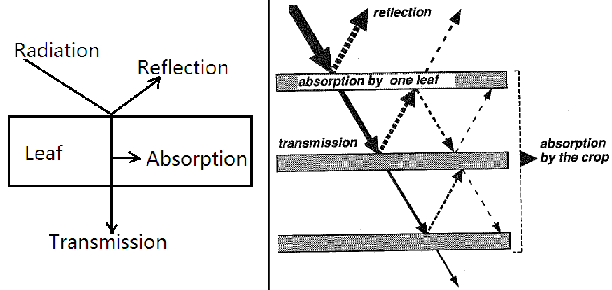Preliminary Course.
Eco-Physiology
Light interception.
Photosynthetically active radiation (PAR)
-
Leaves intercept light.
Chlorophyll, the most abundant plant pigment, is most efficient in capturing red and blue light.
Photosynthetically active radiation, abbreviated PAR, designates the spectral range of solar radiation (from 400 to 700 nanometres) that photosynthetic organisms are able to use in the photosynthesis process.
This spectral region corresponds more or less to the range of light visible to the human eye.
PAR measurement is widely used in agriculture, forestry and oceanography. PAR sensors stationed at various levels of the forest canopy measure the pattern of PAR availability and utilization.
The photosynthetic rate and related parameters can be measured non-destructively using a photosynthesis system, and these instruments measure PAR and sometimes control PAR at set intensities.
PAR is normally quantified as µmol photons per m-2.s-1, which is a measurement of the photosynthetic photon flux (area) density.
In Agronomy, PAR is often expressed in energy units as an irradiance per area (in W.m-2, 1 W.m-2 = 4.57 µmol . m-2.s-1, see McCree, 1972).
At leaf level, part of light energy is reflected, the other part is partially absorbed, and the remaining energy is transmitted.
In a crop, the available light energy thus decreases according to the depth of the leaves in the canopy.
A common method characterizes leaf depths by successive layers.

Distribution of radiation inside a leaf (left) and inside a canopy (right).
(Drawing: E. Heuvelink, WAGENINGEN UNIVERSITY)
Definition
PAR (Photosynthetically Active Radiation)
Physiology (abrev.). PAR defines the wave band of solar radiation that plants are able to use in the process of photosynthesis. In agronomy, PAR is usually expressed in energy units as an irradiance per area. Unit: W.m-2.Bibliography
McCree, Keith J. 1972. The action spectrum, absorptance and quantum yield of photosynthesis in crop plants. Agricultural and Forest Meteorology, 9, pp. 191-216
